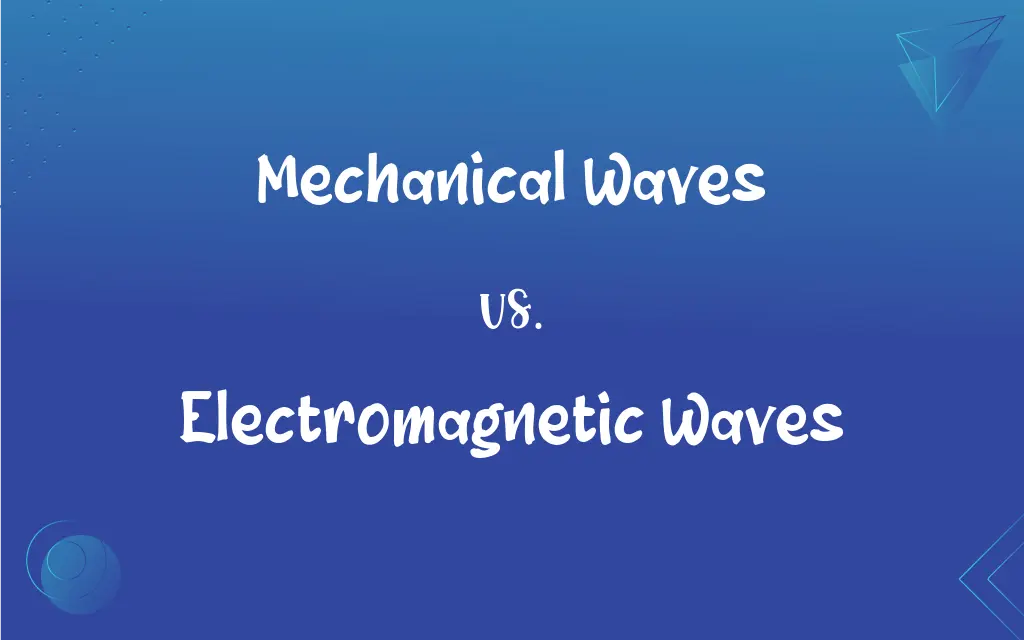Mechanical Waves vs. Electromagnetic Waves: What's the Difference?
Edited by Janet White || By Harlon Moss || Updated on October 17, 2023
Mechanical waves require a medium to travel; electromagnetic waves do not and can travel through a vacuum.

Key Differences
Mechanical waves are disturbances in a material medium that transmit energy from one place to another. In contrast, electromagnetic waves are oscillations of electric and magnetic fields that can propagate through a vacuum.
Examples of mechanical waves include sound waves in air and water waves in a pond. On the other hand, electromagnetic waves encompass a spectrum that includes radio waves, microwaves, and visible light.
While mechanical waves necessitate a medium (like air, water, or solids) for their propagation, electromagnetic waves can traverse the vacuum of outer space. This is why sunlight, which consists of electromagnetic waves, reaches Earth from the Sun.
The speed of mechanical waves depends on the properties of the medium they pass through. Electromagnetic waves, however, always travel at the speed of light in a vacuum, approximately 299,792,458 meters per second.
Mechanical waves can be either transverse (where the disturbance is perpendicular to the direction of propagation) or longitudinal (parallel to the direction). Electromagnetic waves are always transverse, with the electric and magnetic fields oscillating perpendicular to each other and the direction of propagation.
ADVERTISEMENT
Comparison Chart
Requirement of Medium
Require a medium
Can travel through a vacuum
Examples
Sound waves, seismic waves
Radio waves, visible light, X-rays
Speed
Depends on medium
Constant in vacuum (speed of light)
Types of Wave Disturbance
Can be transverse or longitudinal
Always transverse
Ability to Travel in Space
Cannot propagate
Can propagate (e.g., sunlight)
ADVERTISEMENT
Mechanical Waves and Electromagnetic Waves Definitions
Mechanical Waves
These waves need a material medium to propagate.
Sound waves, a type of mechanical wave, require air to reach our ears.
Electromagnetic Waves
They encompass a spectrum, ranging from long radio waves to short gamma rays.
Microwaves used in ovens are a type of electromagnetic wave with a specific frequency.
Mechanical Waves
They transfer energy without permanently displacing the medium.
When water waves pass, they move up and down but return to their original position.
Electromagnetic Waves
Electromagnetic waves always move transversely, with fields oscillating perpendicular to the direction of propagation.
The magnetic field of a light wave oscillates at a right angle to its electric field.
Mechanical Waves
Mechanical waves are disturbances in a medium that carry energy.
When you pluck a guitar string, you create mechanical waves.
Electromagnetic Waves
Electromagnetic waves are oscillations of electric and magnetic fields.
Visible light from a lamp is an electromagnetic wave.
Mechanical Waves
Mechanical waves can be either transverse or longitudinal based on the direction of disturbance.
Sound waves in air are longitudinal mechanical waves.
Electromagnetic Waves
These waves can propagate without a medium, even in a vacuum.
Radio signals from a satellite, which are electromagnetic waves, can travel through the vacuum of space.
Mechanical Waves
The speed of mechanical waves depends on the properties of the medium.
Sound travels faster in water than in air due to the properties of the two mediums.
Electromagnetic Waves
Electromagnetic waves travel at a constant speed in a vacuum, the speed of light.
When light travels from the Sun to Earth, it moves at roughly 299,792,458 meters per second in the vacuum of space.
FAQs
Which wave type encompasses X-rays and ultraviolet light?
Both are part of the electromagnetic wave spectrum.
How do we receive signals from distant satellites or probes?
Through electromagnetic waves, which can propagate through the vacuum of space.
Why can't we hear sounds on the Moon?
The Moon lacks an atmosphere, so there's no medium for the mechanical waves of sound to travel through.
What's a fundamental distinction between mechanical waves and electromagnetic waves?
Mechanical waves require a medium, while electromagnetic waves can travel in a vacuum.
Can sound waves travel in space?
No, sound waves are mechanical waves and need a medium, while space is a vacuum.
Do electromagnetic waves always travel at the speed of light?
In a vacuum, yes, but their speed can be affected when passing through different materials.
What causes the oscillations in electromagnetic waves?
Changes or movements in electric and magnetic fields.
Which type of wave can be polarized?
Electromagnetic waves can be polarized, but mechanical waves typically cannot.
Is visible light a mechanical wave?
No, visible light is an electromagnetic wave.
Do electromagnetic waves have mass?
No, electromagnetic waves are massless and carry energy and momentum.
Why can we see stars millions of light-years away?
The light from stars, being electromagnetic waves, can travel vast distances through the vacuum of space to reach us.
How do mechanical waves transfer energy?
They transfer energy through the vibration or oscillation of particles in a medium.
Can mechanical waves travel through solids?
Yes, for instance, seismic waves travel through the Earth's crust.
Are water waves mechanical waves?
Yes, water waves are an example of mechanical waves in liquids.
Can mechanical waves travel faster in some mediums compared to others?
Yes, for example, sound travels faster in water than in air.
What's the highest frequency electromagnetic wave?
Gamma rays have the highest frequency in the electromagnetic spectrum.
How are electromagnetic waves produced?
They are produced by charged particles, such as electrons, when they accelerate.
Can mechanical waves have different wavelengths?
Yes, they can vary in wavelength, frequency, and amplitude.
What kind of mechanical wave is a sound wave?
Sound waves are longitudinal mechanical waves.
Why can radio signals, which are electromagnetic waves, penetrate walls, but sound, a mechanical wave, is often muffled?
Electromagnetic waves can travel through a vacuum and many materials, while mechanical waves depend on the medium's properties.
About Author
Written by
Harlon MossHarlon is a seasoned quality moderator and accomplished content writer for Difference Wiki. An alumnus of the prestigious University of California, he earned his degree in Computer Science. Leveraging his academic background, Harlon brings a meticulous and informed perspective to his work, ensuring content accuracy and excellence.
Edited by
Janet WhiteJanet White has been an esteemed writer and blogger for Difference Wiki. Holding a Master's degree in Science and Medical Journalism from the prestigious Boston University, she has consistently demonstrated her expertise and passion for her field. When she's not immersed in her work, Janet relishes her time exercising, delving into a good book, and cherishing moments with friends and family.







































































